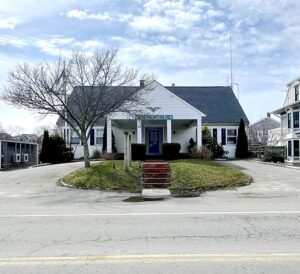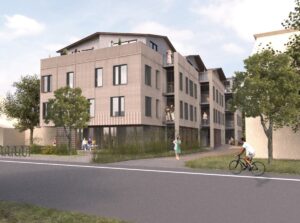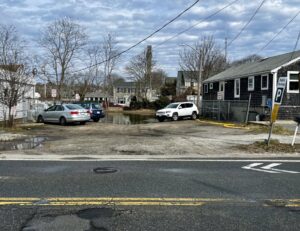PROVINCETOWN — Developers Christine Barker and M. Tatiana Eck, who were picked by the select board last July to build 40 market-rate apartments at the site of the old police station at 26 Shank Painter Road, told the board on March 11 that they hoped to begin construction in spring 2025.

The project first has to be approved by the Cape Cod Commission — a “fairly lengthy process that’s going to take us through the summer,” Barker said — before going to the town’s planning board and zoning board of appeals in the fall.
The pair also told the board that the cost of the project was now estimated at $17 million — about 28 percent more than the $13.3 million they had projected last July. The proposed rents in the building rose by about the same percentage, but their request for a $4 million contribution from the town was unchanged.
The 18 studio apartments were to rent for $1,675 to $2,000 a month last July. Now the rents are $2,175 to $2,500, Barker and Eck said.
The 18 one-bedroom units, which were to rent for $2,500 to $2,750 per month, would now rent for $3,125 to $3,400 per month. The four two-bedroom units were up from $3,000 per month to $3,850.
Because the project was designed using the town’s inclusionary bylaw, 20 percent of the units must be deed-restricted to be affordable to people in a certain income range.

In line with the town’s request for housing targeting median earners, Barker and Eck had proposed that those eight units be restricted to people earning between 80 and 150 percent of area median income. (For a single person, that would be from $67,700 to $127,000 per year; for a couple, it would be from $77,400 to $145,125 per year.)
The other units would be deed-restricted to year-round rental only without affordability rules.
The select board praised the project and appeared willing to offer financial support — but several members worried that the rents were too high.
Leslie Sandberg said that the town was seeking to help working people — including police officers, firefighters, and teachers — who make more than 80 percent of area median income, which is the income limit for the town’s affordable housing projects. She asked Barker and Eck if they could focus their inclusionary units on people earning just over 80 percent.
“Two-thousand one-hundred seventy-five dollars is within the 80- to 150-percent range,” Eck said, citing the rent for the smallest studio apartment. “We could go up to, I believe, $3,150.”
“I guess I’m thinking, can you go down?” Sandberg said. “For the income-restricted units, maybe look at the lower end of what you could do. If a two-bedroom is $3,850, that’s a lot.”
“I think the challenge is that if you’re not able to charge these rents, the project’s not viable,” said board chair Dave Abramson, adding that there might not be enough demand “at the higher end to pay those rents. I don’t see a lot of wiggle room in these financials.”

Barker said that she had seen negative comments on social media, and she wanted to address them.
“To those who say this is motivated by greed — this is a community endeavor,” she said. “We’re taking our collective experience and putting it to good use to build a very good housing complex, and that’s the motivation here.
“We’re coming in at about $425,000 per unit,” Barker said, adding that the apartments at 3 Jerome Smith Road are projected to cost $600,000 per unit. “It’s the reality of how much it costs to build and how expensive it is to borrow money.”
“Thank you for doing this,” said board member John Golden. “As far as the rents go, it comes down to what the market will bear. If you have 40 units and they’re empty because the rents are too high, you have the option to lower them.”
Board member Erik Borg asked if there is any way to secure state or federal funding for the project. Eck said that because the inclusionary bylaw already imposed certain restrictions, the state would not pay more money for the same restrictions — but Town Manager Alex Morse said he was still curious about state funding.
“The workforce housing program provides upwards of $100,000 per unit for restrictions to 80 to 120 percent of median income,” Morse said.
Sandberg said she wanted the town to “hit that sweet spot of people making over $68,000 a year, because they’re being left out.”
Parking
Barker and Eck’s project includes five parking spaces, two of which are for people with disabilities.
“We did briefly look into raising the building to increase parking, which was insanely expensive,” Eck said. “We would get about five usable spaces, given all the columns that would be required, and we would lose 10 apartments.”

Eck said that the 27 metered spaces at the firehouse parking lot across the street could perhaps be converted to parking for town residents only, and that she and Barker were willing to help the town rehabilitate a small public lot at 11 Shank Painter Road that has 15 spaces but is often compromised by poor drainage.
“We did get quotes to turn the swamp back into a parking lot, and they ranged from $100,000 to $250,000,” Barker said.
“I was a little concerned about the parking, but Stop & Shop is just down the street, and Commercial Street is not that far away,” said Golden.
The select board thanked Barker and Eck but did not finalize any new agreements. Morse said the board would discuss its negotiating position on the property in an executive session.
